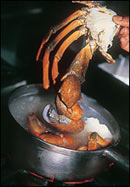 PEOPLE either love to eat crab or they don't. And if they do, then they will eat it only outside, in a restaurant, where the crab comes cooked and very often shelled. Or they will make a show of slipping on an apron and then attacking their Crab Gassi or Crab Butter Pepper Garlic (the most popular crab dishes in Mangalorean seafood restaurants) with the crab crackers that the restaurant supplies them with. It is a messy business. You get your hands and the lower part of your face dirty. And often the crab claw jumps out of your plate and lands on the floor in your attempt to crack it. But most people admit that if they were not put off by the task of cooking crab at home, they would be happiest eating it in the privacy and comfort of their dining rooms, where they could get down to tackling the crustacean with their hands and enjoying the mess they make! If such people only knew how easy it was to cook crab, and how simple the gassi and butter pepper garlic preparations are, most Mangalorean restaurants would lose customers!
PEOPLE either love to eat crab or they don't. And if they do, then they will eat it only outside, in a restaurant, where the crab comes cooked and very often shelled. Or they will make a show of slipping on an apron and then attacking their Crab Gassi or Crab Butter Pepper Garlic (the most popular crab dishes in Mangalorean seafood restaurants) with the crab crackers that the restaurant supplies them with. It is a messy business. You get your hands and the lower part of your face dirty. And often the crab claw jumps out of your plate and lands on the floor in your attempt to crack it. But most people admit that if they were not put off by the task of cooking crab at home, they would be happiest eating it in the privacy and comfort of their dining rooms, where they could get down to tackling the crustacean with their hands and enjoying the mess they make! If such people only knew how easy it was to cook crab, and how simple the gassi and butter pepper garlic preparations are, most Mangalorean restaurants would lose customers!
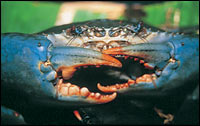 Crabs are like frogs, you get them in water and on land. There are sea crabs and there are rock and mud crabs. All of them taste different. But all of them taste slightly sweet. Crab meat is highly rich in calcium. The trick is to cook it in its shell, that retains the juice, the flavour and the taste of the crab meat. If you crack open the crab shell and scoop out the meat and cook it, you will find it is sometimes like rubber, and very often tasteless. Cook it with the shell. This works as the same principle as meat on the bone. The meat is infinitely more tastier. And in a crab, 70 per cent of the body weight is made up by the shell. It is also advisable to eat the crab six hours after cooking.
Crabs are like frogs, you get them in water and on land. There are sea crabs and there are rock and mud crabs. All of them taste different. But all of them taste slightly sweet. Crab meat is highly rich in calcium. The trick is to cook it in its shell, that retains the juice, the flavour and the taste of the crab meat. If you crack open the crab shell and scoop out the meat and cook it, you will find it is sometimes like rubber, and very often tasteless. Cook it with the shell. This works as the same principle as meat on the bone. The meat is infinitely more tastier. And in a crab, 70 per cent of the body weight is made up by the shell. It is also advisable to eat the crab six hours after cooking.
That's because the shell gets enough time to impart its flavour, aroma and nutritive value to the crab meat. You can reheat the dish and eat it hot. It is also not wise to buy crab on full moon days. For reasons fishermen have no explanations to give, the crab shells are hollow and empty on full moon nights. There is no meat! This is a mystery no seafood expert has addressed yet.
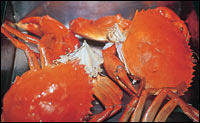 The season to eat crab is monsoon and winter, because it is a heaty food. And if you are prepared to attempt cooking crab at home, then you must source out a good fisherwoman in a market and buy the crab from her. The freshness of a crab lies in its being alive. Never buy dead crab because the meat degenerates, it gets spoilt, quickly. You cannot also refrigerate crab. It must be bought live, killed at home, cooked immediately, and consumed. Society women are reluctant to do this because the crab is quite a ferocious-looking creature. If not handled right, it can pinch off parts of your finger, and to be pinched by a crab is extremely painful.
The season to eat crab is monsoon and winter, because it is a heaty food. And if you are prepared to attempt cooking crab at home, then you must source out a good fisherwoman in a market and buy the crab from her. The freshness of a crab lies in its being alive. Never buy dead crab because the meat degenerates, it gets spoilt, quickly. You cannot also refrigerate crab. It must be bought live, killed at home, cooked immediately, and consumed. Society women are reluctant to do this because the crab is quite a ferocious-looking creature. If not handled right, it can pinch off parts of your finger, and to be pinched by a crab is extremely painful.
All three varieties of crab are sold in Indian fish markets, but the mud and rock crabs are much more tastier than the sea crab. They all look the same but differ in colour and taste. The mud and rock crabs have black shells, their shells are harder than the sea crabs, they are the bigger crustaceans, more meatier, and their meat is tastier and more flavoursome. Naturally, they have more market value. The sea crabs are pink in colour, fairly big, but their claws are thinner. The difference in size and structure probably has to do with the fact that the mud and rock crabs have a more difficult existence than the easy-going life of the sea crab.
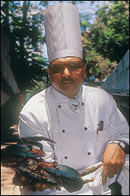 Processed crab meat is an industry abroad, because internationally, crab is the third most popular meat on a seafood lover's list of favourite foods. The blue, soft-shell Boston crab that is famous in the west and is such a delicacy, does not have many takers in India, because people are not used to eating it here. A variety of this crab is available in Kerala, but these are mainly consumed by the fisherfolk who catch them. Very often the fisherfolk toss these crabs into the sea if they do not know its value. And the most popular Indian preparations of crab are the gassi, which is a spicy and tangy curry, and the butter pepper garlic, which is an innovation that clicked, it appeals to the tastebuds of foreigners because it is not as spicy as the gassi.
Processed crab meat is an industry abroad, because internationally, crab is the third most popular meat on a seafood lover's list of favourite foods. The blue, soft-shell Boston crab that is famous in the west and is such a delicacy, does not have many takers in India, because people are not used to eating it here. A variety of this crab is available in Kerala, but these are mainly consumed by the fisherfolk who catch them. Very often the fisherfolk toss these crabs into the sea if they do not know its value. And the most popular Indian preparations of crab are the gassi, which is a spicy and tangy curry, and the butter pepper garlic, which is an innovation that clicked, it appeals to the tastebuds of foreigners because it is not as spicy as the gassi.



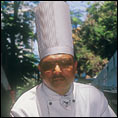 Who�s Afraid Of Cooking Crab At Home!
Who�s Afraid Of Cooking Crab At Home!
 PEOPLE either love to eat crab or they don't. And if they do, then they will eat it only outside, in a restaurant, where the crab comes cooked and very often shelled. Or they will make a show of slipping on an apron and then attacking their Crab Gassi or Crab Butter Pepper Garlic (the most popular crab dishes in Mangalorean seafood restaurants) with the crab crackers that the restaurant supplies them with. It is a messy business. You get your hands and the lower part of your face dirty. And often the crab claw jumps out of your plate and lands on the floor in your attempt to crack it. But most people admit that if they were not put off by the task of cooking crab at home, they would be happiest eating it in the privacy and comfort of their dining rooms, where they could get down to tackling the crustacean with their hands and enjoying the mess they make! If such people only knew how easy it was to cook crab, and how simple the gassi and butter pepper garlic preparations are, most Mangalorean restaurants would lose customers!
PEOPLE either love to eat crab or they don't. And if they do, then they will eat it only outside, in a restaurant, where the crab comes cooked and very often shelled. Or they will make a show of slipping on an apron and then attacking their Crab Gassi or Crab Butter Pepper Garlic (the most popular crab dishes in Mangalorean seafood restaurants) with the crab crackers that the restaurant supplies them with. It is a messy business. You get your hands and the lower part of your face dirty. And often the crab claw jumps out of your plate and lands on the floor in your attempt to crack it. But most people admit that if they were not put off by the task of cooking crab at home, they would be happiest eating it in the privacy and comfort of their dining rooms, where they could get down to tackling the crustacean with their hands and enjoying the mess they make! If such people only knew how easy it was to cook crab, and how simple the gassi and butter pepper garlic preparations are, most Mangalorean restaurants would lose customers! Crabs are like frogs, you get them in water and on land. There are sea crabs and there are rock and mud crabs. All of them taste different. But all of them taste slightly sweet. Crab meat is highly rich in calcium. The trick is to cook it in its shell, that retains the juice, the flavour and the taste of the crab meat. If you crack open the crab shell and scoop out the meat and cook it, you will find it is sometimes like rubber, and very often tasteless. Cook it with the shell. This works as the same principle as meat on the bone. The meat is infinitely more tastier. And in a crab, 70 per cent of the body weight is made up by the shell. It is also advisable to eat the crab six hours after cooking.
Crabs are like frogs, you get them in water and on land. There are sea crabs and there are rock and mud crabs. All of them taste different. But all of them taste slightly sweet. Crab meat is highly rich in calcium. The trick is to cook it in its shell, that retains the juice, the flavour and the taste of the crab meat. If you crack open the crab shell and scoop out the meat and cook it, you will find it is sometimes like rubber, and very often tasteless. Cook it with the shell. This works as the same principle as meat on the bone. The meat is infinitely more tastier. And in a crab, 70 per cent of the body weight is made up by the shell. It is also advisable to eat the crab six hours after cooking. The season to eat crab is monsoon and winter, because it is a heaty food. And if you are prepared to attempt cooking crab at home, then you must source out a good fisherwoman in a market and buy the crab from her. The freshness of a crab lies in its being alive. Never buy dead crab because the meat degenerates, it gets spoilt, quickly. You cannot also refrigerate crab. It must be bought live, killed at home, cooked immediately, and consumed. Society women are reluctant to do this because the crab is quite a ferocious-looking creature. If not handled right, it can pinch off parts of your finger, and to be pinched by a crab is extremely painful.
The season to eat crab is monsoon and winter, because it is a heaty food. And if you are prepared to attempt cooking crab at home, then you must source out a good fisherwoman in a market and buy the crab from her. The freshness of a crab lies in its being alive. Never buy dead crab because the meat degenerates, it gets spoilt, quickly. You cannot also refrigerate crab. It must be bought live, killed at home, cooked immediately, and consumed. Society women are reluctant to do this because the crab is quite a ferocious-looking creature. If not handled right, it can pinch off parts of your finger, and to be pinched by a crab is extremely painful.  Processed crab meat is an industry abroad, because internationally, crab is the third most popular meat on a seafood lover's list of favourite foods. The blue, soft-shell Boston crab that is famous in the west and is such a delicacy, does not have many takers in India, because people are not used to eating it here. A variety of this crab is available in Kerala, but these are mainly consumed by the fisherfolk who catch them. Very often the fisherfolk toss these crabs into the sea if they do not know its value. And the most popular Indian preparations of crab are the gassi, which is a spicy and tangy curry, and the butter pepper garlic, which is an innovation that clicked, it appeals to the tastebuds of foreigners because it is not as spicy as the gassi.
Processed crab meat is an industry abroad, because internationally, crab is the third most popular meat on a seafood lover's list of favourite foods. The blue, soft-shell Boston crab that is famous in the west and is such a delicacy, does not have many takers in India, because people are not used to eating it here. A variety of this crab is available in Kerala, but these are mainly consumed by the fisherfolk who catch them. Very often the fisherfolk toss these crabs into the sea if they do not know its value. And the most popular Indian preparations of crab are the gassi, which is a spicy and tangy curry, and the butter pepper garlic, which is an innovation that clicked, it appeals to the tastebuds of foreigners because it is not as spicy as the gassi.